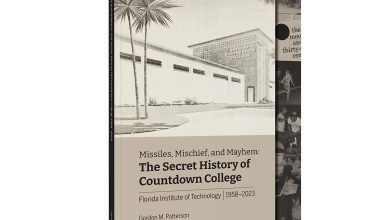The Medieval Origins of Middle Earth: Riddles in the Dark
By Kate Broderick, Global Strategic Communication ’13
While pursuing a Humanities degree at Florida Tech, chances are you’re going to stumble across the Medieval Era in classes like Civilization I, Ancient and Medieval Philosophy, and Mythology. Given the course names, a medieval connection is to be expected—what you might not expect, however, is how frequently aspects of the modern world are founded in the medieval. For example, you may or may not know that the Lord of the Rings is a product of medieval lore and legend.
It is a surreal moment to be sitting in an IMAX movie theatre, eyes glued to the screen, preparing to watch fantastical creatures spring to life in modern 3D glory, and realizing you’re watching a medieval tale unfold. This happened to me recently while watching The Hobbit: An Unexpected Journey. As an avid fan of Tolkien, I went with my classmates from my degree in Global Strategic Communication after class.
The Hobbit: An Unexpected Journey portrays the first portion of Tolkien’s classic The Hobbit. Bilbo Baggins, a curmudgeony, middle-aged hobbit is plucked from his comfortable life when he joins a quest with 13 warlike dwarves in order to steal treasure from a dragon’s hoard. The story serves as a prequel to the Lord of the Rings saga, detailing how Bilbo finds the One Ring. This pivotal moment occurred over a game of riddles between Bilbo and the wretched creature Gollum.
Riddles are quintessentially medieval. During the medieval area, the period of time between the fall of Rome and the renaissance, the average person was illiterate. Lacking the credentials of quality education (like we happily receive as part of our degree in Humanities and degree in Communication at Florida Tech), a person was judged based upon two criteria: wisdom and wit, both of which are demonstrated in the game of riddles.
In the Hervarar saga ok Heiðreks, an epic Norse saga from the 13th century (and touted to be the inspiration for many features of Tolkien’s middle earth—for instance, the tale features the dwarves Durin and Dwalin)—riddles play a pivotal role. At a divisive moment in the course of the saga, the god Odin challenges the king to play a game of riddles. Riddles also feature in the 10th century Anglo-Saxon chronicle the Exeter Book and are said to be divided into five distinct riddling styles: the true riddle, the neck-riddle, the arithmetical puzzle, the clever question, and the conundrum.
With his life on the line, Bilbo saves himself with a neck-question (hence the name: he “saves his neck”). He ponders, “What have I got in my pocket?” Gollum is unable to guess, and Bilbo saves himself from being eaten.
While a course on the art of riddles isn’t part of the humanities curriculum—yet!—you will have plenty of opportunities to immerse yourself in the wittier, clever aspects of medieval culture during your studies in your degree in humanities at Florida Tech!
How do you fare on wit and wisdom? Check for yourself with some of Tolkien’s riddles from The Hobbit:
Riddle 1
It cannot be seen, cannot be felt,
Cannot be heard, cannot be smelt.
It lies behind stars and under hills,
And empty holes it fills.
It comes first and follows after,
Ends life, kills laughter.
Riddle 2
Thirty white horses on a red hill,
First they champ,
Then they stamp,
Then they stand still.
Riddle 3
Voiceless it cries,
Wingless flutters,
Toothless bites,
Mouthless mutters.
Answers: Dark, Teeth, Wind.




